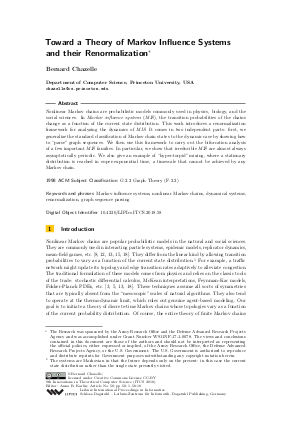Toward a Theory of Markov Influence Systems and their Renormalization
Author Bernard Chazelle
-
Part of:
Volume:
9th Innovations in Theoretical Computer Science Conference (ITCS 2018)
Part of: Series: Leibniz International Proceedings in Informatics (LIPIcs)
Part of: Conference: Innovations in Theoretical Computer Science Conference (ITCS) - License:
 Creative Commons Attribution 3.0 Unported license
Creative Commons Attribution 3.0 Unported license
- Publication Date: 2018-01-12
File

PDF
LIPIcs.ITCS.2018.58.pdf
- Filesize: 1.08 MB
- 18 pages
Document Identifiers
Subject Classification
Keywords
- Markov influence systems
- nonlinear Markov chains
- dynamical systems
- renormalization
- graph sequence parsing
Metrics
- Access Statistics
-
Total Accesses (updated on a weekly basis)
0Document
0Metadata
Abstract
Nonlinear Markov chains are probabilistic models commonly used in physics, biology, and the social sciences. In "Markov influence systems" (MIS), the transition probabilities of the chains change as a function of the current state distribution. This work introduces a renormalization framework for analyzing the dynamics of MIS. It comes in two independent parts: first, we generalize the standard classification of Markov chain states to the dynamic case by showing how to "parse" graph sequences. We then use this framework to carry out the bifurcation analysis of a few important MIS families. In particular, we show that irreducible MIS are almost always asymptotically periodic. We also give an example of "hyper-torpid" mixing, where a stationary distribution is reached in super-exponential time, a timescale that cannot be achieved by any Markov chain.
Cite As Get BibTex
Bernard Chazelle. Toward a Theory of Markov Influence Systems and their Renormalization. In 9th Innovations in Theoretical Computer Science Conference (ITCS 2018). Leibniz International Proceedings in Informatics (LIPIcs), Volume 94, pp. 58:1-58:18, Schloss Dagstuhl – Leibniz-Zentrum für Informatik (2018)
https://doi.org/10.4230/LIPIcs.ITCS.2018.58
BibTex
@InProceedings{chazelle:LIPIcs.ITCS.2018.58,
author = {Chazelle, Bernard},
title = {{Toward a Theory of Markov Influence Systems and their Renormalization}},
booktitle = {9th Innovations in Theoretical Computer Science Conference (ITCS 2018)},
pages = {58:1--58:18},
series = {Leibniz International Proceedings in Informatics (LIPIcs)},
ISBN = {978-3-95977-060-6},
ISSN = {1868-8969},
year = {2018},
volume = {94},
editor = {Karlin, Anna R.},
publisher = {Schloss Dagstuhl -- Leibniz-Zentrum f{\"u}r Informatik},
address = {Dagstuhl, Germany},
URL = {https://drops.dagstuhl.de/entities/document/10.4230/LIPIcs.ITCS.2018.58},
URN = {urn:nbn:de:0030-drops-83317},
doi = {10.4230/LIPIcs.ITCS.2018.58},
annote = {Keywords: Markov influence systems, nonlinear Markov chains, dynamical systems, renormalization, graph sequence parsing}
}
Author Details
References
-
C. Avin, M. Koucký, and Z. Lotker. How to explore a fast-changing world (cover time of a simple random walk on evolving graphs). Proc. 35th ICALP, pages 121-132, 2008.

-
H. Bruin and J.H.B. Deane. Piecewise contractions are asymptotically periodic. Proc. American Mathematical Society, 137(4):1389-1395, 2009.

-
C. Castellano, S. Fortunato, and V. Loreto. Statistical physics of social dynamics. Rev. Mod. Phys., 81:591-646, 2009.

-
B. Chazelle. Diffusive influence systems. SIAM J. Comput., 44:1403-1442, 2015.

-
B. Chazelle, Q. Jiu, Q. Li, and C. Wang. Well-posedness of the limiting equation of a noisy consensus model in opinion dynamics. J. Differential Equations, 263:365-397, 2017.

-
A. Condon and D. Hernek. Random walks on colored graphs. Random Structures and Algorithms, 5:285-303, 1994.

-
A. Condon and R.J. Lipton. On the complexity of space bounded interactive proofs. Proc. 30th IEEE Symp. on Foundations of Computer Science, pages 462-267, 1989.

-
D. Coppersmith and P. Diaconis. Random walk with reinforcement. Unpublished manuscript, 1986.

-
O. Denysyuk and L. Rodrigues. Random walks on directed dynamic graphs. Proc. 2nd International Workshop on Dynamic Networks: Algorithms and Security (DYNAS'10), Bordeaux, France (Also arXiv:1101.5944 (2011)), 2010.

-
O. Denysyuk and L. Rodrigues. Random walks on evolving graphs with recurring topologies. Proc. 28th International Symposium on Distributed Computing (DISC), 2014.

-
R.L. Devaney. An Introduction to Chaotic Dynamical Systems (2nd ed.). Westview Press, 2003.

-
P. Diaconis. Recent progress on de Finetti’s notions of exchangeability. Bayesian Statistics, 3, 1988.

-
T.D. Frank. Strongly nonlinear stochastic processes in physics and the life sciences. ISRN Mathematical Physics, Article ID 149169, 2013.

-
P. Holme and J. Saramäki. Temporal networks. Physics Reports, 519:97-125, 2012.

-
G. Iacobelli and D.R. Figueiredo. Edge-attractor random walks on dynamic networks. J. Complex Networks, 5:84-110, 2017.

-
A. Katok and B. Hasselblatt. Introduction to the Modern Theory of Dynamical Systems. Cambridge University Press, 1996.

-
D. Kempe, J. Kleinberg, and A. Kumar. Connectivity and inference problems for temporal networks. J. Computer and System Sciences, 64:820-842, 2002.

-
V.N. Kolokoltsov. Nonlinear Markov Processes and Kinetic Equations. Cambridge Tracks in Mathematics (182), Cambridge Univ. Press, 2010.

-
M. Othon. An introduction to temporal graphs: an algorithmic perspective. Internet Mathematics, 12, 2016.

-
E. Seneta. Non-Negative Matrices and Markov Chains. Springer, 2nd ed., 2006.

-
S. Sternberg. Dynamical Systems. Dover Books on Mathematics, 2010.

